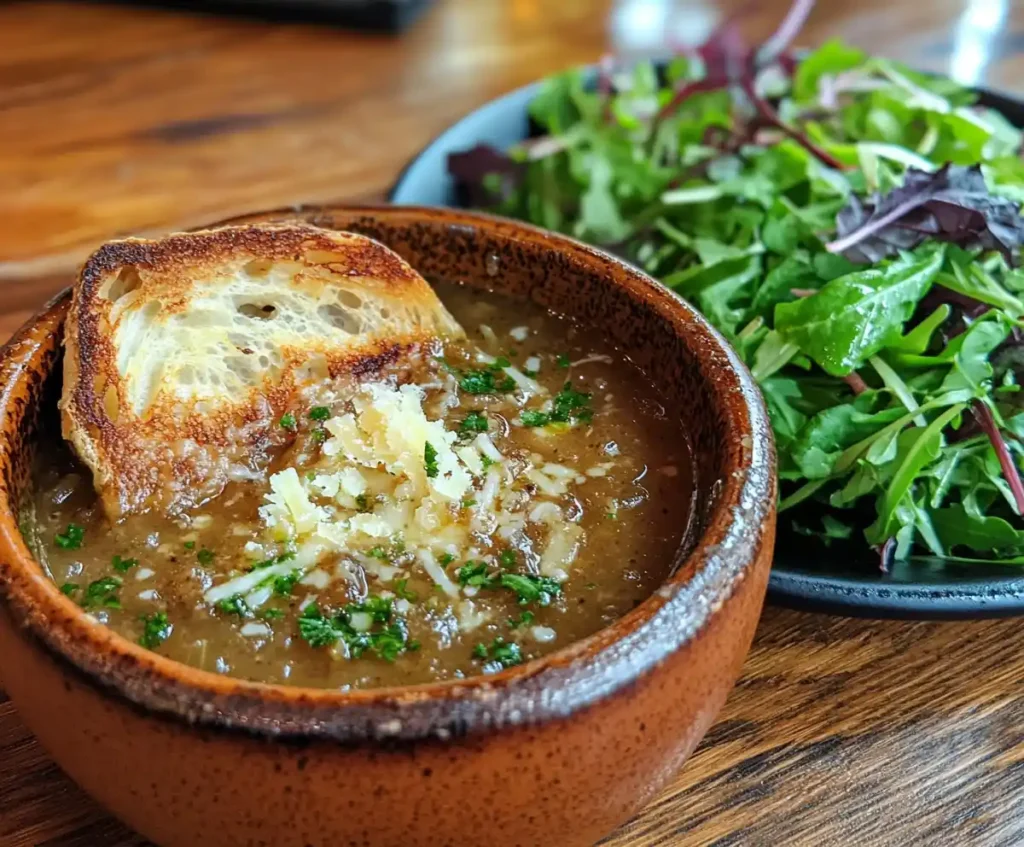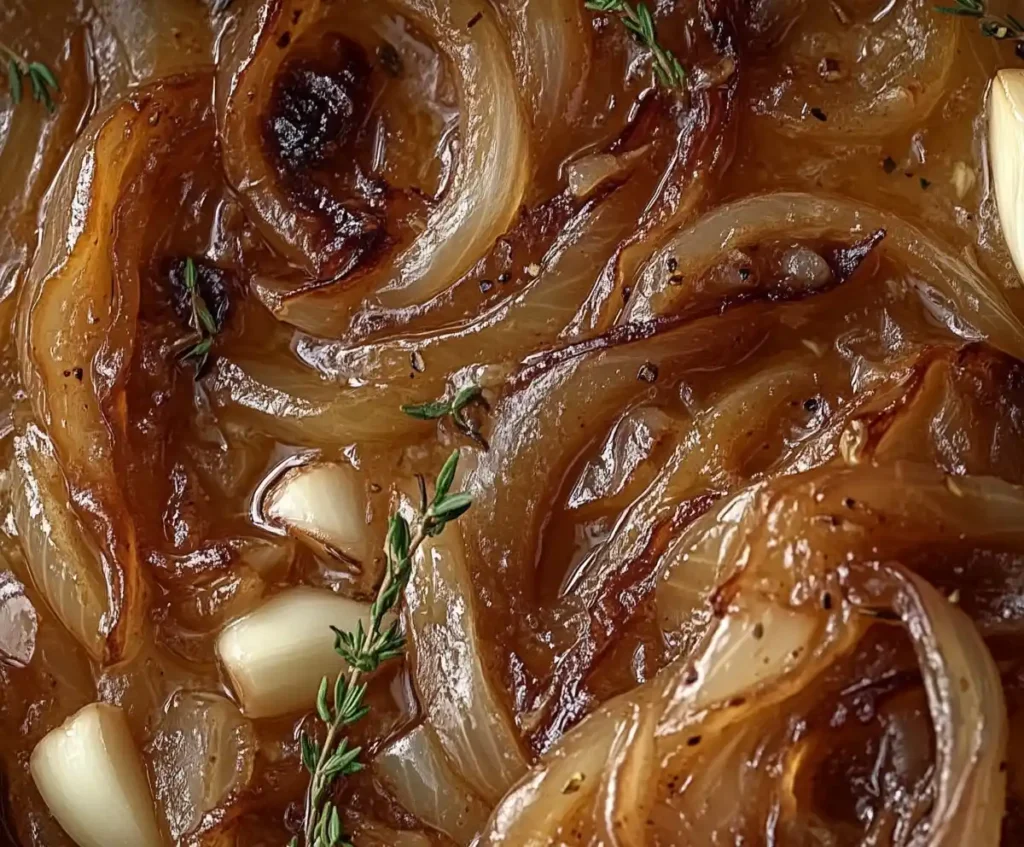
Introduction: Understanding Why French Onion Soup Is High in Calories
French onion soup is undeniably delicious, but have you ever wondered why is French onion soup so high in calories? This seemingly simple dish packs a significant caloric punch, thanks to its rich ingredients and hearty preparation. While it’s a comfort food favorite, its calorie content might surprise even the most seasoned soup enthusiasts. In this article, we’ll explore the components of French onion soup that contribute to its calorie count, compare it to other soups, and discover ways to enjoy a healthier version without compromising on taste.
The Components of French Onion Soup
Core Ingredients: Onions, Broth, and Butter
The foundation of French onion soup begins with caramelized onions, a key ingredient that brings out its signature sweetness. Caramelizing onions involves slow cooking in butter, which adds a luxurious richness but also contributes a hefty amount of calories. Butter, while delicious, is calorie-dense, with each tablespoon packing around 100 calories.
The broth, usually beef-based, also plays a role. While broth itself is relatively low in calories, the type and amount used can vary. For example, richer broths with added fats will naturally increase the calorie content. Still, the broth primarily acts as a flavorful base, leaving the heavier calorie burden to other components.
Cheese and Bread: The High-Calorie Culprits
Here’s where things get interesting. Why is French onion soup so high in calories? The answer lies largely in the cheese and bread. Gruyère, the traditional cheese topping, is melted to perfection, creating a thick, gooey layer. However, Gruyère contains around 400 calories per 100 grams, making it a significant contributor.
Then comes the bread, usually a toasted baguette or crouton, which sits beneath the cheese. This crispy addition soaks up the broth and adds texture but can easily add another 150–200 calories depending on the portion size. Together, the bread and cheese create the irresistible, calorie-rich topping that makes French onion soup so indulgent.
Nutritional Breakdown of French Onion Soup
Calories in Traditional Ingredients
Understanding why is French onion soup so high in calories requires a closer look at its ingredients. Butter, essential for caramelizing onions, is one of the key contributors. A tablespoon of butter adds about 100 calories to the dish. Additionally, caramelized onions, though healthy, become slightly more calorie-dense during the cooking process due to the butter.
Broth, often beef-based in traditional recipes, is relatively low in calories but varies depending on its richness. Adding fats or oils to enhance the broth’s flavor can increase the overall calorie count. Thus, while broth might seem innocent, its preparation can make a difference.
The true calorie heavyweights, however, are the bread and cheese. A generous serving of Gruyère cheese, which melts beautifully, contributes around 400 calories per 100 grams. Likewise, the bread or baguette slice, often toasted and soaked in soup, adds another 150–200 calories. Combined, these toppings significantly boost the calorie count.
Serving Size and Restaurant Variations
Serving size plays a crucial role in the calorie content of French onion soup. Homemade versions tend to be more customizable, allowing for control over portion sizes and ingredient quantities. However, restaurant servings are often larger and more indulgent, with extra cheese and thicker bread slices. In fact, a single bowl at a restaurant might contain upwards of 600–800 calories, depending on preparation.
For a more balanced serving, you can adjust the cheese-to-bread ratio and use smaller bowls. This approach reduces the calorie count without compromising too much on flavor.
Comparing French Onion Soup to Other Soups
French Onion Soup vs. Cream-Based Soups
When comparing French onion soup to cream-based options, the differences become clear. Cream soups, such as chowders or bisques, rely heavily on dairy products like heavy cream or milk. Consequently, they often contain even more calories than French onion soup. For instance, a cup of clam chowder can easily surpass 300 calories due to the cream and butter content.
French onion soup, by contrast, derives its calories from cheese and bread rather than cream. Therefore, while still rich, it’s a lighter option compared to these dairy-heavy alternatives.
French Onion Soup vs. Broth-Based Soups
Broth-based soups, such as vegetable or chicken noodle, are significantly lighter. These options typically avoid high-calorie toppings like cheese and bread. For example, a bowl of vegetable soup might contain only 100–150 calories. French onion soup, on the other hand, delivers a more indulgent experience due to its cheesy, bread-laden topping.
While both types of soups serve different culinary purposes, French onion soup occupies a niche as a hearty, flavor-packed dish. Thus, its calorie count reflects its role as a comfort food rather than a light appetizer.
This section highlights the nutritional composition and provides context by comparing French onion soup with other types of soups. Let me know if you’d like adjustments or additions!
Can French Onion Soup Be Made Healthier?
Reducing Cheese and Bread Without Losing Flavor
Why is French onion soup so high in calories? A major factor is the cheese and bread topping. To make a lighter version, start by reducing the cheese portion. Instead of a thick layer of Gruyère, try sprinkling a smaller amount or mixing it with lower-calorie cheeses like mozzarella. Additionally, using whole-grain bread or a smaller slice can cut calories while maintaining the soup’s texture and appeal.
If you’re looking to retain the rich flavors, consider toasting the bread with a light brush of olive oil rather than butter. This simple switch can reduce calorie content without sacrificing taste.

Low-Fat and Plant-Based Substitutes
For a healthier spin, replace butter with olive oil or a non-dairy alternative to caramelize the onions. Olive oil contains fewer saturated fats and offers heart-healthy benefits. Furthermore, plant-based cheese options, now widely available, work well as substitutes for traditional Gruyère, especially for those on vegan diets.
Experimenting with broth can also make a difference. Using vegetable or low-sodium broth instead of traditional beef broth reduces salt content and makes the soup lighter. These tweaks ensure you can enjoy a comforting bowl of French onion soup with fewer calories.
Portion Control Tips
When aiming to lower the calorie count, portion control becomes essential. Use smaller bowls to manage serving sizes and balance the meal with lighter side dishes like a green salad. Pairing the soup with refreshing options ensures the meal feels complete without being overly heavy.
For more ideas on creative and lighter recipes, check out our French Onion Soup Recipe Tips.
Frequently Asked Questions (FAQs) About French Onion Soup
Why does French onion soup have so much cheese?
French onion soup uses cheese, especially Gruyère, to create its signature gooey, golden topping. Gruyère melts beautifully, forming a thick, indulgent layer over the soup. However, this cheese is calorie-dense, contributing significantly to the dish’s overall calorie count.
Is there a way to reduce the calories in French onion soup?
Yes, you can lower the calories by using less cheese or opting for lower-fat alternatives. In addition, smaller bread portions or using whole-grain bread can help. Switching to a lighter broth and olive oil for caramelizing onions also reduces calorie content.
How do restaurants make French onion soup so rich?
Restaurants often use extra butter for caramelizing onions and generous portions of cheese and bread. These additions make the soup richer and more indulgent but also increase the calorie content. Thus, homemade versions allow more control over ingredients.
What is the healthiest way to enjoy French onion soup?
The healthiest way to enjoy French onion soup is to use smaller portions of cheese and bread, opt for a lighter broth, and incorporate olive oil instead of butter. Pairing the soup with a salad or roasted vegetables also balances the meal.
These sections focus on making French onion soup healthier while answering common questions about the dish. Let me know if you’d like further refinements!
The Role of Preparation Techniques in Calorie Content
The Impact of Caramelizing Onions
A key reason why is French onion soup so high in calories lies in the cooking techniques, particularly caramelizing onions. This process involves slow cooking onions in butter, which not only deepens their flavor but also adds significant calories. Butter, while adding richness, is calorie-dense, contributing around 100 calories per tablespoon. On the other hand, using olive oil as a substitute can lower the calorie count without compromising the caramelization process.
The duration of caramelization also plays a role. Longer cooking times often mean more butter or oil is added to keep the onions moist, which can further increase the calorie total. By carefully measuring fats and limiting additions, you can control the soup’s richness and calorie content.

Cheese Melting and Broiling Techniques
Another calorie-boosting step involves melting cheese over the soup. Traditional French onion soup requires broiling a thick layer of Gruyère cheese until it becomes golden and bubbly. However, this delicious topping can contribute hundreds of calories depending on the portion size.
To reduce calories during this step, consider using a smaller quantity of cheese or mixing Gruyère with a lower-calorie option. Additionally, broiling cheese at higher temperatures for shorter periods prevents excessive cheese usage while maintaining the desired gooey texture.
Cultural Significance and Comfort Food Appeal
Why French Onion Soup Is a Comfort Food Classic
French onion soup’s caloric richness isn’t just about ingredients; it’s also tied to its role as a comfort food. The combination of sweet caramelized onions, hearty broth, melted cheese, and crusty bread creates a meal that feels warm and indulgent. Therefore, it’s often chosen for cozy dinners or as a satisfying starter on cold days.
Its caloric density adds to its comforting appeal, making it a filling option that can stand alone as a meal. Moreover, its long history and association with traditional French cuisine give it a timeless, nostalgic quality that enhances its allure.
Modern Adaptations for a Balanced Diet
While traditional recipes celebrate indulgence, modern versions aim to balance flavor with health. Many chefs now experiment with lighter ingredients to retain the soup’s essence without its hefty calorie count. For example, plant-based cheeses, gluten-free bread, and low-sodium broths are increasingly popular options. Thus, French onion soup continues to evolve, making it accessible to a wider audience.
If you’re interested in creative takes on classic recipes, check out our Modern Comfort Food Ideas.
These sections explore the techniques that contribute to the calorie count and the cultural significance of French onion soup. Let me know if you’d like more details or additional insights!
Balancing French Onion Soup with Other Meals
Pairing French Onion Soup with Lighter Dishes
Why is French onion soup so high in calories? Its rich ingredients make it a hearty dish, but pairing it with lighter sides can help balance your meal. A simple green salad with a tangy vinaigrette works well to offset the richness of the soup. Similarly, roasted vegetables like asparagus or zucchini provide texture and freshness without adding many calories.
For a more filling but balanced meal, pair French onion soup with a lean protein like grilled chicken or baked fish. This combination ensures you get a variety of nutrients without tipping the calorie scales.
Portion Planning for Calorie Control
Portion size is another effective way to enjoy French onion soup without overindulging. Serve smaller bowls as an appetizer rather than a main course, which helps control calorie intake while still letting you savor its comforting flavors. Additionally, reducing the bread and cheese toppings for individual servings can make the dish more calorie-friendly.
By pairing French onion soup thoughtfully and adjusting portions, you can enjoy its indulgent taste as part of a balanced diet.
Final Thoughts on Why French Onion Soup Is So High in Calories
The Dual Role of Ingredients and Preparation
When asking why is French onion soup so high in calories, the answer lies in both its rich ingredients and the techniques used to prepare it. Caramelized onions, melted Gruyère cheese, and toasted bread are the hallmarks of this iconic dish, but they also contribute significantly to its calorie count. However, with small adjustments, such as reducing cheese or using healthier substitutes, the soup can be made lighter without losing its essence.
Enjoying French Onion Soup Responsibly
French onion soup’s indulgent nature makes it a perfect choice for special occasions or as an occasional treat. However, modern adaptations allow you to enjoy it more often by incorporating healthier ingredients. Whether served traditionally or with a lighter twist, this dish remains a beloved staple in French cuisine.
If you’re curious about exploring more recipes that balance flavor and health, don’t forget to check out our Healthy Recipe Collection. French onion soup, like all comfort foods, can fit into a balanced lifestyle with thoughtful preparation.
These sections provide practical tips for balancing French onion soup within a meal and wrap up the discussion with insights into its rich appeal. Let me know if additional edits are needed!

